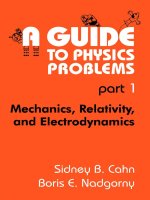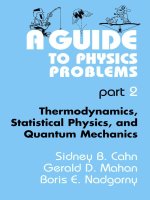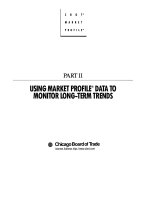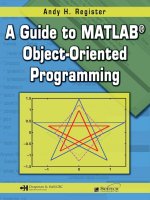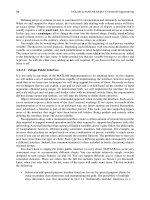- Trang chủ >>
- Khoa Học Tự Nhiên >>
- Vật lý
A guide to physics problems part 2
Bạn đang xem bản rút gọn của tài liệu. Xem và tải ngay bản đầy đủ của tài liệu tại đây (5.71 MB, 374 trang )
Thermodynamics,
Statistical Physics, and
Quantum Mechanics
A GUIDE
TO PHYSICS
PROBLEMS
part 2
This page intentionally left blank
Thermodynamics,
Statistical Physics, and
Quantum Mechanics
Sidney B. Cahn
New York University
New York, New York
Gerald D. Mahan
University of Tennessee
Knoxville, Tennessee, and
Oak Ridge National Laboratory
Oak Ridge, Tennessee
and
Boris E. Nadgorny
Naval Research Laboratory
Washington, D.C.
KLUWER ACADEMIC PUBLISHERS
NEW YORK, BOSTON, DORDRECHT, LONDON, MOSCOW
part 2
eBook ISBN: 0-306-48401-3
Print ISBN: 0-306-45291-X
©2004 Kluwer Academic Publishers
New York, Boston, Dordrecht, London, Moscow
Print ©1997 Kluwer Academic/Plenum Publishers
All rights reserved
No part of this eBook may be reproduced or transmitted in any form or by any means, electronic,
mechanical, recording, or otherwise, without written consent from the Publisher
Created in the United States of America
Visit Kluwer Online at:
and Kluwer's eBookstore at:
New York
Foreword
It is only rarely realized how important the design of suitable, interesting
problems is in the educational process. This is true for the professor — who
periodically makes up exams and problem sets which test the effectiveness
of his teaching — and also for the student — who must match his skills
and acquired knowledge against these same problems. There is a great need
for challenging problems in all scientific fields, but especially so in physics.
Reading a physics paper requires familiarity and control of techniques which
can only be obtained by serious practice in solving problems. Confidence
in performing research demands a mastery of detailed technology which
requires training, concentration, and reflection — again, gained only by
working exercises.
In spite of the obvious need, there is very little systematic effort made
to provide balanced, doable problems that do more than gratify the ego of
the professor. Problems often are routine applications of procedures men-
tioned in lectures or in books. They do little to force students to reflect
seriously about new situations. Furthermore, the problems are often ex-
cruciatingly dull and test persistence and intellectual stamina more than
insight, technical skill, and originality. Another rather serious shortcoming
is that most exams and problems carry the unmistakable imprint of the
teacher. (In some excellent eastern U.S. universities, problems are cata-
logued by instructor, so that a good deal is known about an exam even
before it is written.)
In contrast, A Guide to Physics Problems, Part 2 not only serves an
important function, but is a pleasure to read. By selecting problems from
different universities and even different scientific cultures, the authors have
effectively avoided a one-sided approach to physics. All the problems are
good, some are very interesting, some positively intriguing, a few are crazy;
but all of them stimulate the reader to think about physics, not merely to
train you to pass an exam. I personally received considerable pleasure in
working the problems, and I would guess that anyone who wants to be a
professional physicist would experience similar enjoyment. I must confess
v
Foreword
vi
with some embarrassment that some of the problems gave me more trouble
than I had expected. But, of course, this is progress. The coming generation
can do with ease what causes the elder one trouble. This book will be a
great help to students and professors, as well as a source of pleasure and
enjoyment.
Max Dresden
Stanford
Preface
Part 2 of A Guide to Physics Problems contains problems from written
graduate qualifying examinations at many universities in the United States
and, for comparison, problems from the Moscow Institute of Physics and
Technology, a leading Russian Physics Department. While Part 1 presented
problems and solutions in Mechanics, Relativity, and Electrodynamics, Part
2 offers problems and solutions in Thermodynamics, Statistical Physics, and
Quantum Mechanics.
The main purpose of the book is to help graduate students prepare for
this important and often very stressful exam (see Figure P.1). The
difficulty
and scope of the qualifying exam varies from school to school, but not too
dramatically. Our goal was to present a more or less universal set of problems
that would allow students to feel confident at these exams, regardless of the
graduate school they attended. We also thought that physics majors who are
considering going on to graduate school may be able to test their knowledge
of physics by trying to solve some of the problems, most of which are not
above the undergraduate level. As in Part 1 we have tried to provide as many
details in our solutions as possible, without turning to a trade expression of
an exhausted author who, after struggling with the derivation for a couple of
hours writes, “As it can be easily shown ”
Most of the comments to Part 1 that we have received so far have come not
from the students but from the professors who have to give the exams. The
most typical comment was, “Gee, great, now I can use one of your problems
for our next comprehensive exam.” However, we still hope that this does not
make the book counterproductive and eventually it will help the students to
transform from the state shown in Figure P.1 into a much more comfortable
stationary state as in Figure P.2. This picture can be easily attributed to the
present state of mind of the authors as well, who sincerely hope that Part 3
will not be forthcoming any time soon.
Some of the schools do not have written qualifying exams as part of their
requirements: Brown, Cal-Tech, Cornell, Harvard, UT Austin, University
of Toronto, and Yale. Most of the schools that give such an exam were
vii
Preface
viii
happy to trust us with their problems. We wish to thank the Physics Depart-
ments of Boston University (Boston), University of Colorado at Boulder (Col-
orado), Columbia University (Columbia), University of Maryland (Mary-
land), Massachusetts Institute of Technology (MIT), University of Michi-
gan (Michigan), Michigan State University (Michigan State), Michigan Tech-
nological University (Michigan Tech), Princeton University (Princeton),
Rutgers University (Rutgers), Stanford University (Stanford), State Univer-
sity of New York at Stony Brook (Stony Brook), University ofTennessee at
Knoxville (Tennessee), and University of Wisconsin (Wisconsin-Madison).
The Moscow Institute ofPhysics and Technology (Moscow Phys-Tech) does
not give this type of qualifying exam in graduate school. Some of their prob-
lems came from the final written exam for the physics seniors, some of the
others, mostly introductory problems, are from their oral entrance exams or
Sidney Cahn
New York
Gerald Mahan
Oak Ridge
Boris Nadgorny
Washington, D.C.
magazines such as Kvant. A few of the problems were compiled by the authors
and have never been published before.
We were happy to hear many encouraging comments about Part 1 from
our colleagues, and we are grateful to everybody who took their time to re-
view the book. We wish to thank many people who contributed some of the
problems to Part 2, or discussed solutions with us, in particular Dmitri Averin
(Stony Brook), Michael Bershadsky (Harvard), Alexander Korotkov (Stony
Brook), Henry Silsbee (Stony Brook), and Alexei Stuchebrukhov (UC Davis).
We thank Kirk McDonald (Princeton) and Liang Chen (British Columbia)
for their helpful comments to some problems in Part 1; we hope to include
them in the second edition of Part 1, coming out next year. We are indebted
to Max Dresden for writing the Foreword, to Tilo Wettig (Münich) who read
most, of the manuscript, and to Vladimir Gitt and Yair Minsky who drew the
humorous pictures.
Preface
ix
This page intentionally left blank
Textbooks Used in the
Preparation of this
Volume
Chapter 4 — Thermodynamics and Statistical Physics
Landau, L. D., and Lifshitz, E. M., Statistical Physics, Volume 5,
part 1 of Course of Theoretical Physics, 3rd ed., Elmsford, New York:
Pergamon Press, 1980
Kittel, C., Elementary Statistical Physics, New York: John Wiley and
Sons, Inc., 1958
Kittel, C., and Kroemer, H., Thermal Physics, 2nd ed., New York:
Freeman and Co., 1980
Reif, R., Fundamentals of Statistical and Thermal Physics, New York:
McGraw-Hill, 1965
Huang, K., Statistical Mechanics, 2nd ed., New York: John Wiley
and Sons, Inc., 1987
Pathria, R. K., Statistical Mechanics, Oxford: Pergamon Press, 1972
1)
2)
3)
4)
5)
6)
Chapter 5
—
Quantum Mechanics
Liboff, R. L., Introductory Quantum Mechanics, 2nd ed., Reading,
MA: Pergamon Press, 1977
Landau, L. D., and Lifshitz, E. M., Quantum Mechanics, Nonrela-
tivistic Theory, Volume 3 of Course of Theoretical Physics, 3rd ed.,
Elmsford, New York: Pergamon Press, 1977
xi
2)
1)
xii
Textbooks Used in the Preparation of this Volume
Sakurai, J. J., Modern Quantum Mechanics, Menlo Park: Benjamin/
Cummings, 1985
Sakurai, J. J., Advanced Quantum Mechanics, Menlo Park: Benja-
min/Cummings, 1967
Schiff, L. I., Quantum Mechanics, 3rd ed., New York: McGraw-Hill,
1968
Shankar, R., Principles of Quantum Mechanics, New York: Plenum
Press, 1980
3)
4)
5)
6)
Contents
PART I: PROBLEMS
Thermodynamics and Statistical Physics
4.
Introductory Thermodynamics
Why Bother?
(
Moscow Phys-Tech)
Space Station Pressure (MIT)
Baron von Münchausen and Intergalactic Travel (Moscow
Phys-Tech)
Railway Tanker
(
Moscow Phys-Tech
)
Magic Carpet
(
Moscow Phys-Tech)
Teacup Engine
(
Princeton, Moscow Phys-Tech
)
Grand Lunar Canals
(
Moscow Phys-Tech)
Frozen Solid
(
Moscow Phys-Tech
)
Tea in Thermos
(
Moscow Phys-Tech
)
Heat Loss
(
Moscow Phys-Tech
)
Liquid–Solid–Liquid
(
Moscow Phys-Tech
)
Hydrogen Rocket
(
Moscow Phys-Tech
)
Maxwell–Boltzmann Averages (MIT)
Slowly Leaking Box
(
Moscow Phys-Tech, Stony Brook
(a,b))
Surface Contamination
(
Wisconsin-Madison
)
Bell Jar
(
Moscow Phys-Tech
)
Hole in Wall (Princeton)
Ballast Volume Pressure
(
Moscow Phys-Tech
)
Rocket in Drag (Princeton)
Adiabatic Atmosphere (Boston, Maryland)
xiii
4.15.
4.16.
4.17.
4.18.
4.19.
4.20.
4.10.
4.11.
4.12.
4.13.
4.14.
4.4.
4.5.
4.6.
4.7.
4.8.
4.9.
4.1.
4.2.
4.3.
3
4
3
4
5
5
6
7
7
8
8
9
9
9
9
10
10
11
11
12
13
3
4.21.
4.22.
xiv
Atmospheric Energy (Rutgers)
Puncture (Moscow Phys-Tech)
Heat and Work
Cylinder with Massive Piston (Rutgers, Moscow
Phys-Tech)
Spring Cylinder (Moscow Phys-Tech)
Isothermal Compression and Adiabatic Expansion of
Ideal Gas (Michigan)
Isochoric Cooling and Isobaric Expansion (Moscow
Phys-Tech
)
Venting (Moscow Phys-Tech)
Cylinder and Heat Bath (Stony Brook)
Heat Extraction (MIT, Wisconsin-Madison)
Heat Capacity Ratio (Moscow Phys-Tech)
Otto Cycle (Stony Brook)
Joule Cycle (Stony Brook)
Diesel Cycle (Stony Brook)
Modified Joule–Thomson (Boston)
Ideal Gas and Classical Statistics
Poisson Distribution in Ideal Gas (Colorado)
Polarization of Ideal Gas (Moscow Phys-Tech)
Two-Dipole Interaction (Princeton)
Entropy of Ideal Gas (Princeton)
Chemical Potential of Ideal Gas (Stony Brook)
Gas in Harmonic Well (Boston)
Ideal Gas in One-Dimensional Potential
(Rutgers)
Equipartition Theorem (Columbia, Boston)
Diatomic Molecules in Two Dimensions (Columbia)
Diatomic Molecules in Three Dimensions (Stony Brook,
Michiga
n
State)
Two-Level System (Princeton)
Zipper (Boston)
Hanging Chain (Boston)
Molecular Chain (MIT, Princeton, Colorado)
Nonideal Gas
Heat Capacities (Princeton)
Return of Heat Capacities (Michigan)
Nonideal Gas Expansion (Michigan State)
van der Waals (MIT)
4.49.
4.50.
4.51.
4.52.
4.45.
4.46.
4.47.
4.48.
4.35.
4.36.
4.37.
4.38.
4.39.
4.40.
4.41.
4.42.
4.43.
4.44.
4.27.
4.28.
4.29.
4.30.
4.31.
4.32.
4.33.
4.34.
4.26.
4.24.
4.25.
4.23.
Contents
13
14
14
14
15
15
16
16
16
16
17
17
18
18
19
19
19
20
20
20
21
21
21
21
22
23
24
24
24
25
26
26
26
27
27
Contents
xv
4.53.
Critical Parameters (Stony Brook)
Mixtures and Phase Separation
Entropy of Mixing (Michigan, MIT)
Leaky Balloon (Moscow Phys-Tech)
Osmotic Pressure (MIT)
Clausius–Clapeyron (Stony Brook)
Phase Transition (MIT)
Hydrogen Sublimation in Intergalactic Space (Princeton)
Gas Mixture Condensation (Moscow Phys-Tech)
Air Bubble Coalescence (Moscow Phys-Tech)
Soap Bubble Coalescence (Moscow Phys-Tech)
Soap Bubbles in Equilibrium (Moscow Phys-Tech)
Quantum Statistics
Fermi Energy of a 1D Electron Gas (Wisconsin-Madison)
Two-Dimensional Fermi Gas (MIT, Wisconson-Madison)
Nonrelativistic Electron Gas (Stony Brook,
Wisconsin-Madison, Michigan State)
Ultrarelativistic Electron Gas (Stony Brook)
Quantum Corrections to Equation of State (MIT,
Princeton, Stony Brook)
Speed of Sound in Quantum Gases (MIT)
Bose Condensation Critical Parameters (MIT)
Bose Condensation (Princeton, Stony Brook)
How Hot the Sun? (Stony Brook)
Radiation Force (Princeton, Moscow Phys-Tech, MIT)
Hot Box and Particle Creation (Boston, MIT)
D-Dimensional Blackbody Cavity (MIT)
Fermi and Bose Gas Pressure (Boston)
Blackbody Radiation and Early Universe (Stony Brook)
Photon Gas (Stony Brook)
Dark Matter (Rutgers)
Einstein Coefficients (Stony Brook)
Atomic Paramagnetism (Rutgers, Boston)
Paramagnetism at High Temperature (Boston)
One-Dimensional Ising Model (Tennessee)
Three Ising Spins (Tennessee)
N
Independent Spins (Tennessee)
N Independent Spins, Revisited (Tennessee)
Ferromagnetism (Maryland, MIT)
Spin Waves in Ferromagnets (Princeton, Colorado)
4.69.
4.70.
4.71.
4.72.
4.73.
4.74.
4.75.
4.76.
4.77.
4.78.
4.79.
4.80.
4.81.
4.82.
4.83.
4.84.
4.85.
4.86.
4.87.
4.88.
4.67.
4.68.
4.64.
4.65.
4.66.
4.54.
4.55.
4.56.
4.57.
4.58.
4.59.
4.60.
4.61.
4.62.
4.63.
28
28
28
28
28
29
30
30
30
31
31
31
32
32
32
32
33
33
33
34
34
34
35
35
36
36
37
37
38
39
39
40
40
40
41
41
41
42
xvi
Contents
42
42
43
43
43
44
44
44
44
45
45
45
45
46
46
47
47
47
48
49
51
51
51
52
52
53
54
54
54
55
55
55
56
56
Fluctuations
4.89.
4.90.
4.91.
4.92.
4.93.
4.94.
4.95.
4.96.
Applications to Solid State
4.97.
4.98.
4.99.
4.100.
4.101.
4.102.
4.103.
4.104.
4.105.
4.106.
5.
Quantum Mechanics
5.1.
5.2.
5.3.
5.4.
5.5.
5.6.
5.7.
5.8.
5.9.
5.10.
5.11.
5.12.
Magnetization Fluctuation (Stony Brook)
Gas Fluctuations
(Moscow Phys-Tech)
Quivering Mirror
(MIT, Rutgers, Stony Brook)
Isothermal Compressibility and Mean Square Fluctuation
(Stony Brook)
Energy Fluctuation in Canonical Ensemble
(Colorado,
Ston
y
Brook)
Number Fluctuations
(Colorado (a,b), Moscow
Phys-Tech (c))
Wiggling Wire
(Princeton)
LC
Voltage Noise
(MIT, Chicago)
Thermal Expansion and Heat Capacity (Princeton)
Schottky Defects
(Michigan State, MIT)
Frenkel Defects
(Colorado, MIT)
Two-Dimensional Debye Solid
(Columbia, Boston)
Einstein Specific Heat
(Maryland, Boston)
Gas Adsorption
(Princeton, MIT, Stanford)
Thermionic Emission
(Boston)
Electrons and Holes
(Boston, Moscow Phys-Tech)
Adiabatic Demagnetization
(Maryland)
Critical Field in Superconductor
(Stony Brook, Chicago)
One-Dimensional Potentials
Shallow Square Well I
(Columbia)
Shallow Square Well II
(Stony Brook)
Attractive Delta Function Potential I
(Stony Brook)
Attractive Delta Function Potential II
(Stony Brook)
Two Delta Function Potentials
(Rutgers)
Transmission Through a Delta Function Potential
(Michiga
n
State, MIT, Princeton)
Delta Function in a Box
(MIT)
Particle in Expanding Box
(Michigan State, MIT, Stony
Brook
)
One-Dimensional Coulomb Potential
(Princeton)
Two Electrons in a Box (MIT)
Square Well
(MIT)
Given the Eigenfunction
(Boston, MIT)
Contents
xvii
5.13.
Combined Potential
(Tennessee)
56
Harmonic Oscillator
5.14.
5.15.
5.16.
5.17.
5.18.
56
56
57
57
58
5.19.
5.20.
5.21.
58
59
59
60
60
60
60
61
61
61
62
62
63
63
63
63
63
64
64
64
64
65
66
66
66
66
67
67
67
68
5.43.
5.44.
5.38.
5.39.
5.40.
5.41.
5.42.
5.37.
5.31.
5.32.
5.33.
5.34.
5.35.
5.36.
5.22.
5.23.
5.24.
5.25.
5.26.
5.27.
5.28.
5.29.
5.30.
Given a Gaussian (MIT)
Harmonic Oscillator ABCs (Stony Brook)
Number States (Stony Brook)
Coupled Oscillators (MIT)
Time-Dependent Harmonic Oscillator I
(Wisconsin-Madison
)
Time-Dependent Harmonic Oscillator II (Michigan State)
Switched-on Field (MIT)
Cut the Spring! (MIT)
Angular Momentum and Spin
Given Another Eigenfunction (Stony Brook)
Algebra of Angular Momentum (Stony Brook)
Triplet Square Well (Stony Brook)
Dipolar Interactions (Stony Brook)
Spin-Dependent Potential
(MIT)
Three Spins (Stony Brook)
Constant Matrix Perturbation (Stony Brook)
Rotating Spin (Maryland, MIT)
Nuclear Magnetic Resonance (Princeton, Stony Brook)
Variational Calculations
Anharmonic Oscillator (Tennessee)
Linear Potential I (Tennessee)
Linear Potential II (MIT, Tennessee)
Return of Combined Potential (Tennessee)
Quartic in Three Dimensions (Tennessee)
Halved Harmonic Oscillator (Stony Brook, Chicago (b),
Princeton (b))
Helium Atom (Tennessee)
Perturbation Theory
Momentum Perturbation (Princeton)
Ramp in Square Well (Colorado)
Circle with Field (Colorado, Michigan State)
Rotator in Field (Stony Brook)
Finite Size of Nucleus (Maryland, Michigan State,
Princeton, Stony Brook)
U and Perturbation (Princeton)
Relativistic Oscillator (MIT, Moscow Phys-Tech, Stony
Broo
k
(a))
xviii
Contents
5.45.
5.46.
5.47.
5.48.
5.49.
5.50.
5.51.
5.52.
68
68
69
69
69
70
70
70
5.53.
5.54.
5.55.
5.56.
5.57.
5.58.
5.59.
5.60.
71
71
71
71
72
72
73
73
73
5.61.
5.62.
5.63.
5.64.
5.65.
5.66.
5.67.
5.68.
5.69.
73
73
74
75
75
76
76
76
77
77
77
77
78
78
78
79
79
79
5.70.
5.71.
5.72.
5.73.
5.74.
5.75.
5.76.
Spin Interaction
(Princeton)
Spin–Orbit Interaction
(Princeton)
Interacting Electrons
(MIT)
Stark Effect in Hydrogen
(Tennessee)
Hydrogen with Electric and Magnetic Fields
(MIT)
Hydrogen in Capacitor
(Maryland, Michigan State)
Harmonic Oscillator in Field
(Maryland, Michigan State)
of Tritium
(Michigan State)
WKB
Bouncing Ball
(Moscow Phys-Tech, Chicago)
Truncated Harmonic Oscillator
(Tennessee)
Stretched Harmonic Oscillator
(Tennessee)
Ramp Potential
(Tennessee)
Charge and Plane
(Stony Brook)
Ramp Phase Shift
(Tennessee)
Parabolic Phase Shift
(Tennessee)
Phase Shift for Inverse Quadratic
(Tennessee)
Scattering Theory
Step-Down Potential
(Michigan State, MIT)
Step-Up Potential
(Wisconsin-Madison)
Repulsive Square Well
(Colorado)
3D Delta Function
(Princeton)
Two-Delta-Function Scattering
(Princeton)
Scattering of Two Electrons
(Princeton)
Spin-Dependent Potentials
(Princeton)
Rayleigh Scattering
(Tennessee)
Scattering from Neutral Charge Distribution
(Princeton)
General
Spherical Box with Hole
(Stony Brook)
Attractive Delta Function in 3D
(Princeton)
Ionizing Deuterium
(Wisconsin-Madison)
Collapsed Star (Stanford)
Electron in Magnetic Field
(Stony Brook, Moscow
Phys-Tech
)
Electric and Magnetic Fields
(Princeton)
Josephson Junction
(Boston)
Contents
PART II: SOLUTIONS
xix
4.
Thermodynamics and Statistical Physics
Introductory Thermodynamics
4.1.
4.2.
4.3.
4.4.
4.5.
4.6.
4.7.
4.8.
4.9.
4.10.
4.11.
4.12.
4.13.
4.14.
4.15.
4.16.
4.17.
4.18.
4.19.
4.20.
4.21.
4.22.
4.23.
4.24.
4.25.
4.26.
4.27.
4.28.
4.29.
4.30.
83
83
83
84
84
85
87
89
90
92
92
94
95
96
97
99
101
102
103
104
106
107
108
110
112
112
113
115
117
118
119
120
122
Why Bother?
(Moscow
Phys-Tech)
Space Station Pressure (MIT)
Baron von Münchausen and Intergalactic Travel
(
Moscow
Phys-Tech)
Railway Tanker
(
Moscow Phys-Tech
)
Magic Carpet
(
Moscow Phys-Tech
)
Teacup Engine
(
Princeton, Moscow Phys-Tech
)
Grand Lunar Canals (Moscow Phys-Tech)
Frozen Solid
(Moscow Phys-Tech)
Tea in Thermos
(Moscow Phys-Tech)
Heat Loss
(Moscow Phys-Tech)
Liquid–Solid–Liquid
(Moscow Phys-Tech)
Hydrogen Rocket
(Moscow Phys-Tech)
Maxwell–Boltzmann Averages (MIT)
Slowly Leaking Box (Moscow Phys-Tech, Stony Brook
(a,b))
Surface Contamination (Wisconsin-Madison)
Bell Jar
(Moscow Phys-Tech)
Hole in Wall
(Princeton)
Ballast Volume Pressure
(Moscow Phys-Tech)
Rocket in Drag
(Princeton)
Adiabatic Atmosphere (Boston, Maryland)
Atmospheric Energy
(Rutgers)
Puncture
(Moscow Phys-Tech)
Heat and Work
Cylinder with Massive Piston
(Rutgers, Moscow
Phys-Tech)
Spring Cylinder
(Moscow Phys-Tech)
Isothermal Compression and Adiabatic Expansion of
Ideal Gas (Michigan)
Isochoric Cooling and Isobaric Expansion
(Moscow
Phys-Tech)
Venting
(Moscow Phys-Tech)
Cylinder and Heat Bath (Stony Brook)
Heat Extraction
(MIT, Wisconsin-Madison)
Heat Capacity Ratio
(Moscow Phys-Tech)
xx
Contents
123
125
126
127
4.31.
4.32.
4.33.
4.34.
128
128
130
131
133
135
136
137
138
141
4.35.
4.36.
4.37.
4.38.
4.39.
4.40.
4.41.
4.42.
4.43.
4.44.
142
146
147
148
149
4.45.
4.46.
4.47.
4.48.
151
151
152
154
155
156
4.49.
4.50.
4.51.
4.52.
4.53.
4.54.
4.55.
4.56.
4.57.
4.58.
4.59.
4.60.
4.61.
4.62.
4.63.
158
158
159
160
162
163
164
165
166
167
168
170
170
171
4.64.
4.65.
Otto Cycle (Stony Brook)
Joule Cycle (Stony Brook)
Diesel Cycle (
Stony
Brook)
Modified Joule–Thomson
(Boston)
Ideal Gas and Classical Statistics
Poisson Distribution in Ideal Gas (Colorado)
Polarization of Ideal Gas (Moscow Phys-Tech)
Two-Dipole Interaction (Princeton)
Entropy of Ideal Gas (Princeton)
Chemical Potential of Ideal Gas (Stony Brook)
Gas in Harmonic Well (Boston)
Ideal Gas in One-Dimensional Potential (Rutgers)
Equipartition Theorem (Columbia, Boston)
Diatomic Molecules in Two Dimensions (Columbia)
Diatomic Molecules in Three Dimensions (Stony Brook,
Michigan State)
Two-Level System (Princeton)
Zipper (Boston)
Hanging Chain (Boston)
Molecular Chain (MIT, Princeton, Colorado)
Nonideal Gas
Heat Capacities (Princeton)
Return of Heat Capacities (Michigan)
Nonideal Gas Expansion (Michigan State)
van der Waals (MIT)
Critical Parameters (Stony Brook)
Mixtures and Phase Separation
Entropy of Mixing (Michigan, MIT)
Leaky Balloon (Moscow Phys-Tech)
Osmotic Pressure (MIT)
Clausius–Clapeyron
(Stony
Brook)
Phase Transition (MIT)
Hydrogen Sublimation in Intergalactic Space (Princeton)
Gas Mixture Condensation (Moscow Phys-Tech)
Air Bubble Coalescence (Moscow Phys-Tech)
Soap Bubble Coalescence (Moscow Phys-Tech)
Soap Bubbles in Equilibrium (Moscow Phys-Tech)
Quantum
Statistics
Fermi Energy of a 1D Electron Gas
(Wisconsin-Madison)
Two-Dimensional Fermi Gas (MIT, Wisconson-Madison)
Contents
xxi
4.66.
4.67.
4.68.
4.69.
4.70.
4.71.
4.72.
4.73.
4.74.
4.75.
4.76.
4.77.
4.78.
4.79.
4.80.
4.81.
4.82.
4.83.
4.84.
4.85.
4.86.
4.87.
4.88.
4.89.
4.90.
4.91.
4.92.
4.93.
207
207
209
210
210
212
216
219
221
223
223
226
226
174
177
180
181
182
183
185
189
189
191
192
194
196
197
200
203
204
204
205
205
206
172
173
4.95.
4.96.
4.94.
4.97.
4.98.
4.99.
Nonrelativistic Electron Gas (Stony Brook,
Wisconsin-Madison
,
Michigan State)
Ultrarelativistic Electron Gas (Stony Brook)
Quantum Corrections to Equation of State (MIT,
Princeton
,
Stony Brook)
Speed of Sound in Quantum Gases (MIT)
Bose Condensation Critical Parameters (MIT)
Bose Condensation (Princeton, Stony Brook)
How Hot the Sun? (Stony Brook)
Radiation Force (Princeton, Moscow Phys-Tech, MIT)
Hot Box and Particle Creation (Boston, MIT)
D
-Dimensional Blackbody Cavity (MIT)
Fermi and Bose Gas Pressure (Boston)
Blackbody Radiation and Early Universe (Stony Brook)
Photon Gas (Stony Brook)
Dark Matter (Rutgers)
Einstein Coefficients (Stony Brook)
Atomic Paramagnetism (Rutgers, Boston)
Paramagnetism at High Temperature (Boston)
One-Dimensional Ising Model (Tennessee)
Three Ising Spins (Tennessee)
N Independent Spins (Tennessee)
N
Independent Spins, Revisited (Tennessee)
Ferromagnetism (Maryland, MIT)
Spin Waves in Ferromagnets (Princeton, Colorado)
Fluctuations
Magnetization Fluctuation (Stony Brook)
Gas Fluctuations (Moscow Phys-Tech)
Quivering Mirror (MIT, Rutgers, Stony Brook)
Isothermal Compressibility and Mean Square Fluctuation
(Ston
y
Brook)
Energy Fluctuation in Canonical Ensemble (Colorado,
Stony Brook)
Number Fluctuations (Colorado (a,b), Moscow
Phys-Tech (c))
Wiggling Wire (Princeton)
LC Voltage Noise (MIT, Chicago)
Applications to Solid State
Thermal Expansion and Heat Capacity (Princeton)
Schottky Defects (Michigan State, MIT)
Frenkel Defects (Colorado, MIT)
xxii
Contents
4.100.
4.101.
4.102.
4.103.
4.104.
4.105.
4.106.
228
230
232
234
236
238
241
Two-Dimensional Debye Solid (Columbia, Boston)
Einstein Specific Heat (Maryland, Boston)
Gas Adsorption (Princeton, MIT, Stanford)
Thermionic Emission (Boston)
Electrons and Holes
(Boston, Moscow
Phys-Tech)
Adiabatic Demagnetization (Maryland)
Critical Field in Superconductor (Stony Brook, Chicago)
Quantum Mechanics
One-Dimensional Potentials
5.1.
5.2.
5.3.
5.4.
5.5.
5.6.
5.9.
5.10.
5.11.
5.12.
5.13.
Shallow Square Well I (Columbia)
Shallow Square Well II
(Stony
Brook)
Attractive Delta Function Potential I
(Stony Brook)
Attractive Delta Function Potential II (Stony Brook)
Two Delta Function Potentials (Rutgers)
Transmission Through a Delta Function Potential
(Michigan State, MIT, Princeton)
Delta Function in a Box (MIT)
Particle in Expanding Box (Michigan State, MIT, Stony
Br0ook)
One-Dimensional Coulomb Potential (Princeton)
Two Electrons in a Box (MIT)
Square Well
(MIT)
Given the Eigenfunction (Boston, MIT)
Combined Potential
(Tennessee)
Harmonic Oscillator
5.14.
5.15.
5.16.
5.17.
5.18.
5.19.
5.20.
5.21.
Given a Gaussian (MIT)
Harmonic Oscillator ABCs
(Stony Brook)
Number States
(Stony
Brook)
Coupled Oscillators
(MIT)
Time-Dependent Harmonic Oscillator I
(Wisconsin-Madison)
Time-Dependent Harmonic Oscillator II
(Michigan
State)
Switched-on Field
(MIT)
Cut the Spring!
(MIT)
243
243
243
244
245
247
248
250
250
251
253
253
255
255
256
257
257
258
260
262
263
263
264
265
266
266
267
269
271
272
Angular Momentum and Spin
5.22.
5.23.
5.24.
5.25.
5.26.
Given Another Eigenfunction
(Stony Brook)
Algebra of Angular Momentum
(Stony Brook)
Triplet Square Well (Stony Brook)
Dipolar Interactions
(Stony Brook)
Spin-Dependent Potential
(MIT)
5.
5.7.
5.8.
Contents
xxiii
5.27.
5.28.
5.29.
5.30.
Variational Calculations
5.31.
5.32.
5.33.
5.34.
5.35.
5.36.
5.37.
Perturbation Theory
5.38.
5.39.
5.40.
5.41.
5.42.
5.43.
5.44.
5.45.
5.46.
5.47.
5.48.
5.49.
5.50.
5.51.
5.52.
WKB
5.53.
5.54.
5.55.
5.56.
5.57.
5.58.
5.59.
5.60.
Three Spins (Stony Brook)
Constant Matrix Perturbation (Stony Brook)
Rotatin
g Spin (Maryland, MIT)
Nuclear Magnetic Resonance (Princeton, Stony Brook)
Anharmoni
c Oscillator (Tennessee)
Linear Potential I (Tennessee)
Linear Potential II (MIT, Tennessee)
Return of Combined Potential
(Tennessee)
Quarti
c
in Three Dimensions
(Tennessee)
Halved Harmonic Oscillator
(Stony Brook,
Chicago (b),
Princeton (b))
Helium Atom
(Tennessee)
Momentum Perturbation (Princeton)
Ramp in Square Well (Colorado)
Circle with Field (Colorado, Michigan State)
Rotator in Field (Stony Brook)
Finite Size of Nucleus
(Maryland, Michigan State,
Princeton, Stony Brook)
U and Perturbation (Princeton)
Relativistic Oscillator
(MIT, Moscow Phys-Tech, Stony
Brook (a))
Spin Interaction (Princeton)
Spin–Orbi
t
Interaction (Princeton)
Interactin
g
Electrons (MIT)
Star
k
Effect in Hydrogen (Tennessee)
Hydroge
n
with Electric and Magnetic Fields (MIT)
Hydroge
n
in Capacitor
(Maryland,
Michigan State)
Harmoni
c
Oscillator in Field (Maryland, Michigan State)
o
f
Tritium (Michigan State)
Bouncing Ball
(Moscow
Phys-Tech, Chicago)
Truncated Harmonic Oscillator
(Tennessee)
Stretched Harmonic Oscillator
(Tennessee)
Ramp Potential
(Tennessee)
Charge and Plane
(Stony
Brook)
Ramp Phase Shift
(Tennessee)
Parabolic Phase Shift (Tennessee)
Phase Shift for Inverse Quadratic
(Tennessee)
272
274
275
276
278
278
279
280
281
282
283
286
287
287
288
289
290
290
292
293
297
297
298
299
300
302
303
305
305
305
306
307
308
309
310
311
311
xxiv
Contents
Scattering
Theory
312
312
312
313
315
316
317
318
320
321
5.61.
5.62.
5.63.
5.64.
5.65.
5.66.
5.67.
5.68.
5.69.
322
322
323
324
324
5.70.
5.71.
5.72.
5.73.
5.74.
5.75.
5.76.
328
329
330
335
336
336
337
337
338
341
342
342
342
343
344
344
345
345
34
7
Step-Down Potential (Michigan State, MIT)
Step-Up Potential (Wisconsin-Madison)
Repulsive Square Well (Colorado)
3D Delta Function
(Princeton)
Two-Delta-Function Scattering (Princeton)
Scattering of Two Electrons (Princeton)
Spin-Dependent Potentials (Princeton)
Rayleigh Scattering (Tennessee)
Scattering from Neutral Charge Distribution (Princeton)
General
Spherical Box with Hole (Stony Brook)
Attractive Delta Function in 3D (Princeton)
Ionizing Deuterium (Wisconsin-Madison)
Collapsed Star (Stanford)
Electron in Magnetic Field (Stony Brook, Moscow
Phys-Tech)
Electric and Magnetic Fields (Princeton)
Josephson Junction (Boston)
PART III: APPENDIXES
Approximate Values of Physical Constants
Some Astronomical Data
Other Commonly Used Units
Conversion Table from Rationalized MKSA to Gaussian Units
Vector Identities
Vector Formulas in Spherical and Cylindrical Coordinates
Legendre Polynomials
Rodrigues’ Formula
Spherical Harmonics
Harmonic Oscillator
Angular Momentum and Spin
Variational Calculations
Normalized Eigenstates of Hydrogen Atom
Conversion Table for Pressure Units
Useful Constants
Bibliography

